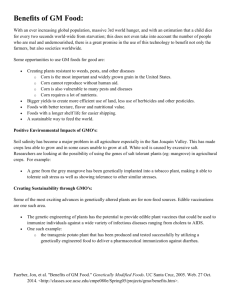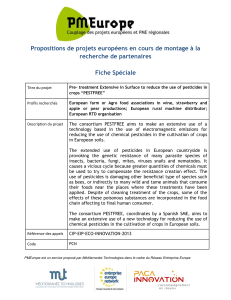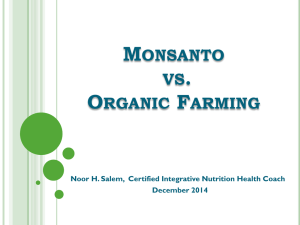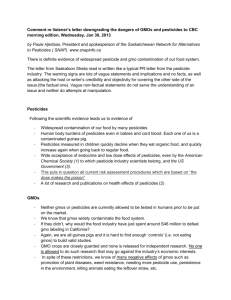The Good, The Bad, and The Downright Ugly: Genetically Modified... Agricultural Pesticides May Determine Adverse Health Effects in Humans.
advertisement
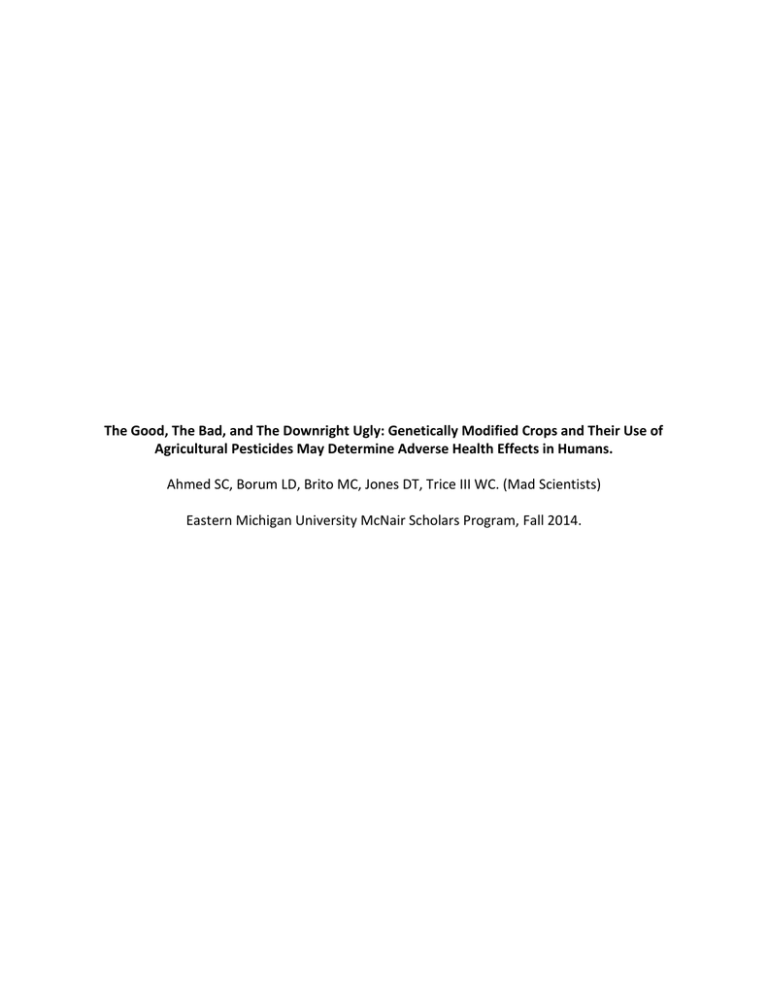
The Good, The Bad, and The Downright Ugly: Genetically Modified Crops and Their Use of Agricultural Pesticides May Determine Adverse Health Effects in Humans. Ahmed SC, Borum LD, Brito MC, Jones DT, Trice III WC. (Mad Scientists) Eastern Michigan University McNair Scholars Program, Fall 2014. ABSTRACT Genetically modified organisms (GMO) are artificially selected plants with favorable traits that are molecularly changed in their biological processes (Bakshi, 2003). In recent years, GMO’s have become a replacement for organically grown plants due to abundance in quantity, economic profit, and the ability to isolate favorable nutritional qualities. The process of genetic splicing involves activating and deactivating the genetic material of the organism in a laboratory. Alterations in formation and structure of different proteins in the plants thus allow for pesticide resistance (Benbrook, 2004). This experiment will specifically analyze certain GMO’s to determine the health liability for human consumption. The goal is to discover whether the orientation of the GMOs or their pesticide resistance is the possible factor for adverse health effects. We propose that through the study of the formation and structure of proteins by a protein assay and a consumption analysis done with mice, we can determine whether the GMO’s themselves are a source of health effects or the residual pesticide resistance. INTRODUCTION Technology is one aspect of human civilization that has evolved our way of living. From the cultivation of crops in 6000 BCE by the Mesopotamians to the domestication of livestock by southwestern Asians over 10,000 years ago, our improvements in food supply has known no bounds (Bernstein et al., 2003). In recent years, technology has added to sustaining our food supply by genetically manipulating organisms through breeding that has doubled production in countries since the 1960’s and 1970’s (Bakshi, 2003). Furthermore, genetic modifications have slowly started shifting towards livestock, but most manufacturers of genetically modified organisms (GMO’s) are hesitant to manipulate a broader range of animal genetics due to possible adverse health effects (Bakshi, 2003). Agricultural crops, however, especially in the US and UK, have proven to be the most accepted form of GMO’s. While the idea of breeding and selection is not new, innovative biotechnological methods have allowed for the selection of certain traits and proteins in organisms. This type of molecular breeding is able to change the very foundation of crops with only a minute amount of modification (Dona et al., 2009). Crops such as corn, wheat, barley, and even strawberries are able to now endure changes in their genome and prosper as they grow, because many are engineered to protect against harmful insects and weeds (Benbrook, 2004). Since the introduction of wide scale agriculture, the use of pesticides has become a fundamental factor because they prevent damage to and consumption of valuable crops by insects and weed. Pesticides can control or prevent the growth of any living organism; the two that are most important to this topic are herbicides and insecticides, which are used for plants and arthropods, respectively. However, one consequence of pesticide use is that many crops become ruined, or are not digestible due to the overuse of these substances. By 1996, GM modified crops became more common because they are able to express a bacterial toxin called Bacillus thuringiensis, or Bt, that allows them to form a crystalline structure that is deadly to most insects and are fully pesticides resistant (Benbrook, 2004). Nonetheless, despite the evidence that many of the GM crops are pesticide resistant, it has been reported that the ratio of crop to pesticide use has only increased (Pimentel, 2001). Thus, for the foreseeable future, GM crops will continue to increase pesticide use rather than reducing their amounts to healthy levels (Pimentel, 2001). This steady rise in herbicide and pesticide use has thus prompted these two critical about the public health effects of GMO’s: (1) Will the proteins in the modified crops have potential side effects, such as toxicity, food allergies, or impaired nutrition, and (2): if adverse side effects were to occur, is it the GMO or the pesticide that is causing the health issues? With extensive research into GMOs and pesticides, many have found a correlation between the modified food and rise in certain illnesses, creating an important implication for human health. Studies have suggested, given the potential toxicity of these environmental pollutants and the fragility of a fetus, many pregnant women and their fetuses are highly susceptible to the adverse effects of xenobiotics, which are foreign chemical substances, found within some organisms, that have been genetically altered (Aris et al., 2011). Knowing more about GMOs is crucial, because modified agents in certain foods could disrupt the biological events that are required to ensure normal growth and development (Aris et al., 2011). Women, may especially be susceptible to illness due to the types of pesticides used on GM crops (Thongprakaisang et al., 2013). For example, a study has examined that many women were at risk for breast cancer, infertility, and thyroid disorders through glyphosate found in the pesticide used by Monsanto, a global giant in the GMO industry (Thongprakaisang et al., 2013). Glyphosates act as endocrine disruptors, which are chemicals that can interfere with the hormone system in mammals. These disruptors can cause developmental disorders, birth defects and cancer tumors (Thongprakaisang et al., 2013). Possible threats of food borne allergies from certain GMO’s found in vitro have further motivated many biotechnology companies to discontinue their development (Bakshi, 2003). Some studies have also suggested that molecular breeding can alter genetic makeup to an extent that toxicity might increase in certain crops, while nutrition decreases (Bakshi, 2003). Despite numerous claims, literature is still inconsistent on what actually causes many of these illnesses. Some report it is the alteration of the GMO, while others suggest the overuse of pesticides and herbicides that is naturally absorbed (Bernstein et al., 2003). This inconsistency may be accredited to the process which many people go about ascertaining their results. Some studies used animal trials to test toxicity, while other experimental groups used human clinical trials that test health risks and digestibility of the GMO’s (Thongprakaisang et al., 2013). Thus, distinguishing a full-rounded methodology and study is crucial in determining whether GMO’s create potential health risks, and if adverse side effects do occur, what their potential source is. METHODOLOGY There can be two ways to approach this experiment to gain more comprehensive results. One will be to take protein assays of the various genetically modified components in our chosen species and comparing it to the proteins in the species that is not genetically modified. We will pay special attention to proteins modified to secrete a bacterial toxin called Bacillus thuringiensis, or Bt. This will require us to also evaluate the stereochemistry of these proteins. This will be beneficial because it helps to determine if the pesticides in the GMOs are harmful to human consumption. Analyzing pesticides used on GMOs would involve chemically breaking down pesticide into its component molecules to determine whether they are harmful to the human body. This could give us data on whether the pesticides are causing the risk of allergy reactions to consumers. Another method involves testing the consumption of a GMO crop with lab rats to determine if the any adverse health effects occur. Corn will be our experimental crop. We will need 3 groups of mice. One variable will be a group of mice that will be fed GM corn that has not been treated with pesticides, another that will be fed GM corn treated with pesticides, and our control group will be fed non GM corn. Each of these groups will be bred and raised independently from each other. We will be observing behavior and development during their lifetime, and performing autopsies and DNA analysis when they die. We will also look closely on cause of death and reproductive vitality. PROJECT TIMELINE Week 1 - 10 Protein assays and analysis. Break down different aspects of pesticides and herbicides that are commonly used on the different strained of corn we are analyzing. Predictions on what will take place in mice trials. Week 11 - 30 Begin first generation of mice trials. Test for as many generations as possible, but four generations should be enough, for possible health affect linked to consumption of the GM corns. PROJECT BUDGET MATERIALS & AMOUNT EXPENSE 30 Mice - Peromyscus leucopus $2,000 Three cages w/ exercise equipment $1,000 Filtered water $500 Water bottles (50) $500 Untreated organic corn feed (50 lbs) $750 Three types of organic corn being used (10 $1,000 bags) Dissection equipment $5,000 Protein Assay Enzymes, Bt (2 bottles) $600 TOTAL: $11,350 WORKS CITED 1. Aris A, Leblanc S. (2011). Maternal and fetal exposure to pesticides associated to genetically modified foods in Eastern Townships of Quebec, Canada. Reproductive Toxicology, 31(4), 528533. 2. Bakshi A. (2003). Potential adverse health effects of genetically modified crops. Journal of Toxicology and Environmental Health Part B: Critical Reviews, 6(3), 211-226. 3. Benbrook C (2004). Genetically engineered crops and pesticide use in the United States: the first nine years. Union of Concerned Scientists. 4. Bernstein JA, Bernstein IL, Bucchini L, Goldman LR, Hamilton RG, Lehrer S, Sampson HA. (2003). Clinical and laboratory investigation of allergy to genetically modified foods. Environmental health perspectives, 111(8), 1114. 5. Dona A, Arvanitoyannis IS. (2009). Health risks of genetically modified foods. Critical reviews in food science and nutrition, 49(2), 164-175. 6. Pimentel D. (2001). Overview of the use of genetically modified organisms and pesticides in agriculture. Indiana Journal of Global Legal Studies, 51-64. 7. Thongprakaisang S, Thiantanawat A, Rangkadilok N, Suriyo T, Satayavivad J. (2013). Glyphosate induces human breast cancer cells growth via estrogen receptors. Food and Chemical Toxicology, 59, 129-136.


